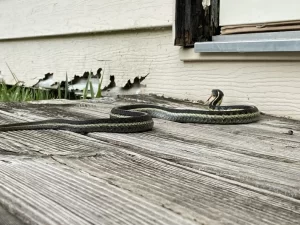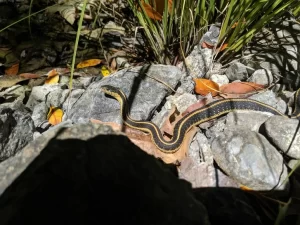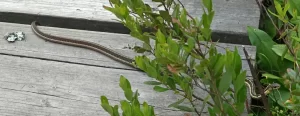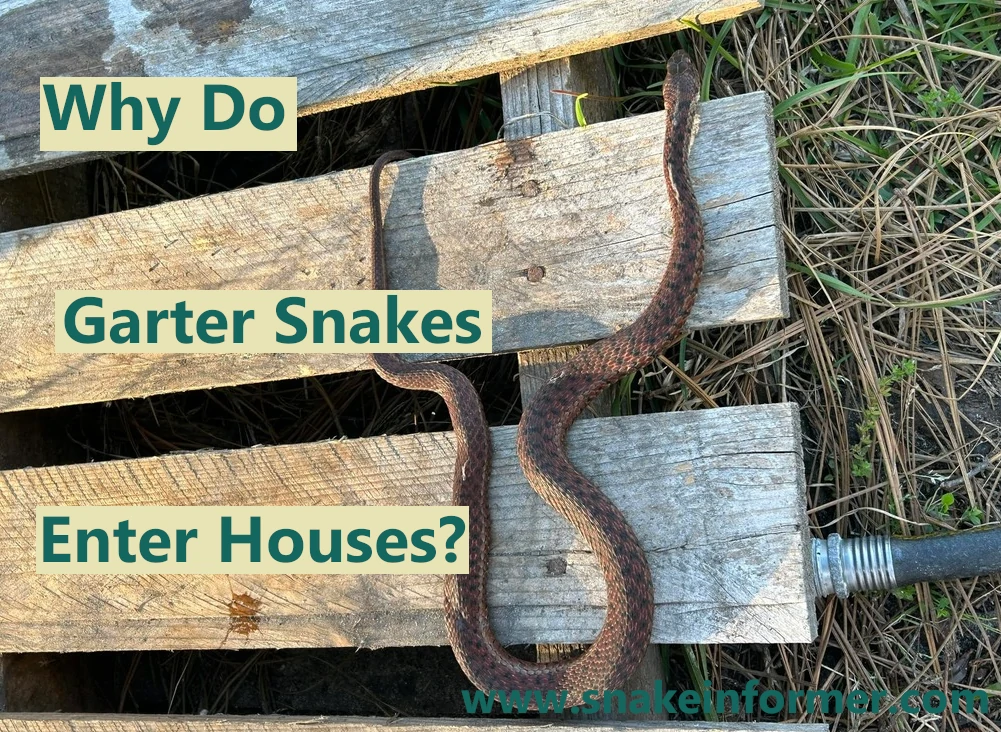Garter snakes are among the most common snakes in North America. They are usually found in forest areas but often wander into people’s backyards and even enter homes.
Garter snakes enter houses mainly in search of food, water, or protection from the elements. Sometimes, they may enter a house purely by accident, especially if doors or windows are left open.
Once inside the house, snakes tend to gravitate towards dark, hidden areas.
It is common to find garter snakes in basements, garages, crawl spaces, or even under furniture or behind household appliances such as refrigerators.
Garter Snakes Typically Enter Houses on the Ground Floor
Although garter snakes can climb, they are typically not very arboreal and will spend most of their time on the ground.
For this reason, most garter snakes that come into your house enter on the ground floor.
Since snakes don’t dig, the only way garter snakes can enter your home is through open spaces.
This could be:
- Gaps under doors
- Cracks or openings in walls
- Pet doors
- Pipes
- Vents
- Any other space that leads to your house
If a window or door is left even just a few inches open, an adult garter snake can squeeze through.

Sometimes, garter snakes will also climb up short walls with irregular surfaces, and make their way into your home.
In addition, garter snakes could hide in large plants or objects outdoors, and then find themselves inside, when these are transferred indoors.
6 Reasons Why Garter Snakes Enter Houses
There are several reasons why a garter snake may enter your house. It may be searching for a meal, or even escaping a predator outdoors.
Here are 6 reasons why a garter snake may enter your home.
1. Search for a Meal
Garter snakes are carnivorous predators, that hunt insects, and small animals such as rats, mice, frogs, and lizards.
Trash piles, birds seed, or even uneaten pet food left outdoors, can attract mice, insects, and lizards which feed on the insects.
The presence of these creatures can attract Garter snakes searching for a meal – and these snakes may wander into your house.
Even if there are no rodents in your home, garter snakes may still get in, on their search for food.
2. Search for Water Or Moisture
All animals need water to survive, and garter snakes are no exception.
These snakes often slither into people’s homes in search of water, or moisture.
They may seek out leaky water pipes, or other damp areas such as sinks, toilets, or bathrooms.
3. Search for Shelter
Like all reptiles, garter snakes are cold-blooded (ectothermic) animals.
This means they cannot internally regulate their body temperature. Instead, their body temperature changes with the temperature in their surroundings.
In other, their environment is the main influence on their body temperature.
As the temperature changes at different times of day and night, they move around in their environment to regulate their body heat. This is known as “thermoregulation.”
When their body temperature is low, they move into the sun to warm up, when it is high, they move to the shade to cool down.
On hot sunny days, garter snakes can be attracted to the cool shade of your house, and may seek out damp areas to hide.

In the wild these snakes often hide in spaces under rocks, to escape the heat, and many areas of your home can provide a similar environment.
During cold months, garter snakes may enter your house in search of a place to overwinter.
4. Habitat Disruption
Sometimes garter snakes may wander into your home because their habitat has been disrupted.
For example, in areas that experience flooding, snakes often move to higher ground and may be driven into people’s homes, seeking safety.
In addition, human destruction of forest areas may also lead to these snakes ending up inside nearby houses, in their search for new shelter.
5. Safe Breeding Nests
Garter snakes often enter houses looking for warm, dry locations that are free of predators to nest and reproduce.
Snakes typically nest in dark areas of the house, so a dark basement or crawlspace can be used for nesting.
Unlike many snakes, garter snakes do not lay eggs. Instead, they give birth to live young, with each female having anywhere from 15 to as many as 40 babies per mating season.
6. Accidental Entry
Garter snakes can also get into your house entirely by accident.
If you leave a window or door open even slightly open, a garter snake can easily slither inside.
6 Tips to Prevent Garter Snakes From Entering Your House
If you want to stop garter snakes from coming into your house, you have to make the area less attractive to them.
Here are a number of things you can do to keep garter snakes from entering your house.
1. Keep Mice and Other Small Animals Away From Your House
One of the easiest ways of keeping snakes away is to get rid of the “snake food” (prey animals) you have in or around your house.
You can do this by getting rid of trash piles, or anything that may attract rodents or insects.
Ensure that food scraps are disposed of properly, as rats and mice are attracted to places where they can find food.
Also, avoid leaving uneaten pet food outdoors, and consider storing any bird seed in rodent-proof containers.
In essence, make sure there is nothing in or around your house that can attract mice, or other animals that garter snakes prey on.
2. Seal All Entryways
Block off as many possible entryways to your house as possible, to reduce the chance of a garter snake slithering inside.
Screen all outside vents, seal cracks and holes around the foundation, and make sure doors and windows fit tightly.
In addition, seal off access to basements and crawlspaces.

Garter snakes can squeeze through spaces only a few inches wide, so even tiny holes should be blocked off.
3. Keep Your Grass Short
Tall grass provides the perfect cover for snakes to hide in. It also attracts mice, and other small animals that garter snakes prey on.
Keep your grass, and other vegetation around the house short. This will discourage garter snakes from coming into your yard, and into your home.
It will also make it easy to spot the snakes that do end up in your yard so you can get rid of them.
4. Clear Dead Leaves and Other Dead Vegetation
Snakes love to hide under dead logs and leaf litter on the ground.
Getting rid of these will keep garter snakes away because they will have fewer places to hide.
5. Keep Firewood, Compost Piles, and Other Types of Debris Away From Your Home
Snakes love to hide in well-covered areas outside. Compost piles or stacks of firewood and lumber are the perfect places for garter snakes to hide.
If these are kept close to the house, garter snakes can easily make their way inside.
Store firewood, lumber, and other piles of debris away from your home.
6. Be Vigilant During the Warm Seasons of the Year
Snakes and other reptiles are most active when the temperatures are warm.
Be alert during this time of the year and watch for any garter snakes that may end up in your yard, so they do not get inside the house.
Conclusion
Garter snakes are some of the most common snakes in North America, and these snakes often enter people’s homes.
Snakes will never come into your house with the intention of causing harm.
Instead, they often end up inside the house in search of food, shelter, or even by accident.
Snakes will prefer to avoid humans, so any garter snakes that enter your home will seek out hidden areas and can stay undiscovered for several days or even weeks.
That said, it’s important to note that garter snakes are not bad to have around. They are generally harmless to humans and help keep the population of rodents and other pests down.
Hi, my name is Ezra Mushala, i have been interested animals all my life. I am the main author and editor here at snakeinformer.com.

